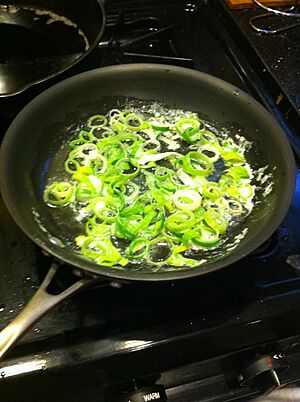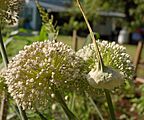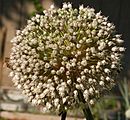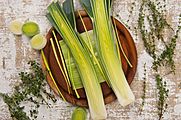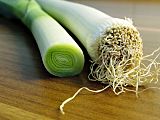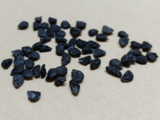Leek facts for kids
Quick facts for kids Leek |
|
|---|---|
 |
|
| Scientific classification | |
| Kingdom: | |
| Division: | |
| Class: | |
| Order: | |
| Family: | |
| Genus: | |
| Species: | |
| Subspecies: |
A. ampeloprasum var. porrum
|
| Trinomial name | |
| Allium ampeloprasum var. porrum (L.) J.Gay
|
|
A leek is a tasty vegetable that looks a bit like a giant green onion! It's related to onions and garlic, belonging to the same plant family called Allium. Leeks are often used in cooking because of their mild, sweet flavor. They are similar to Chinese onions but are usually much bigger.
Contents
Growing Leeks
Leeks are quite easy to grow from seeds. They can stay in the ground for a long time, sometimes up to six months, before they are ready to be picked. For leeks to grow well, the soil needs to be loose and drain water easily. You can grow leeks in the same places where onions grow.
When to Harvest Leeks
Leeks usually grow to their full size by autumn. You can pick them early when they are small, about the size of your finger or a pencil. Or, you can let them grow much larger. Farmers sometimes pile soil around the base of the leeks, which helps them grow bigger and whiter.
Leek Pests and Diseases
Just like other plants, leeks can sometimes get sick or be bothered by insects. Tiny insects called thrips and a bug called the leek moth can cause problems. Leeks can also get a plant disease called leek rust, which is caused by a type of fungus.
Cooking with Leeks
Leeks have a gentle, onion-like taste that isn't too strong. When they are raw, they are crunchy and firm. The parts of the leek you can eat are the white bottom, the light green middle, and sometimes the darker green tops. The very dark green parts are often tough, so people usually throw them away. However, you can cook them or add them to soups to give flavor. Sometimes, chefs tie a few leek leaves with other herbs to make a special flavor bundle called a bouquet garni.
How to Prepare Leeks
Leeks are usually cut into slices about 5 to 10 millimeters thick. Because they have many layers, the slices might fall apart easily. Here are some ways to cook them:
- Boiling: Cooking leeks in boiling water makes them soft and gives them a very mild taste. Be sure to chop them first, or their long fibers can get tangled when you chew.
- Frying: Frying leeks keeps them a bit crunchy and helps them keep more of their flavor.
- Raw: You can use raw leeks in salads. They taste especially good when they are the main ingredient.
Leeks in Different Cuisines
Leeks are used in many dishes around the world.
- In Turkish cuisine, leeks are often chopped, boiled, and then filled with a mix of rice, herbs like parsley and dill, onion, and black pepper. Sometimes, they add currants, pine nuts, and cinnamon for a sweet and sour taste, or minced meat for a heartier dish. Popular Turkish leek dishes include leek with olive oil, sour leek, leek with meat, leek musakka, leek börek (a pastry), and leek meatballs.
- Leeks are also a key ingredient in famous soups like cock-a-leekie soup, leek and potato soup, and vichyssoise.
In Wales, leeks are very important (you'll learn why below!). They are used a lot in Welsh cooking. In other parts of Britain, leeks have become popular again only in the last 50 years, after not being used much for a long time.
Leeks in History
People have been eating leeks for a very long time! The Hebrew Bible mentions a vegetable that many believe was the leek, saying it was common in ancient Egypt. Scientists have found dried leeks at old Egyptian sites, and there are pictures of them on ancient walls. This shows that leeks were part of the Egyptian diet at least 2,000 years before the Common Era. Texts also show that leeks were grown in Mesopotamia around the same time. The Roman Emperor Nero loved leeks and ate them often, believing they helped his singing voice.
Cultural Significance of Leeks

The leek is one of the national symbols of Wales. People in Wales often wear a leek, along with the daffodil, on Saint David's Day. There's a story that an old Welsh king, Cadwaladr, told his soldiers to wear leeks on their helmets. This helped them tell who was on their side during a battle against the Saxons that happened in a leek field. Another story says that Saint David, the patron saint of Wales, ate only leeks when he was fasting.
No matter the exact reason, the leek has been a symbol of Wales for a very long time. The famous writer William Shakespeare even wrote about it as an "ancient tradition" in his play Henry V. In the play, King Henry V tells a Welsh officer that he also wears a leek because he is Welsh. You can even find a leek design on some old British one pound coins, representing Wales.
The Welsh leek also appeared on the special dress worn by Elizabeth II for her coronation. It was placed alongside other national flower symbols from countries connected to the United Kingdom, like the English Tudor rose, Scottish thistle, and Irish shamrock.
Perhaps the most famous use of the leek as a symbol is on the cap badge of the Welsh Guards. This is a special army group in the British Army. In Romania, the leek is also a symbol of the Oltenia region. In Albania in the early 1990s, people protesting against the government would wave leeks to show their hardship, as leeks had become a main food for many.
Gallery
See also
 In Spanish: Puerro para niños
In Spanish: Puerro para niños


